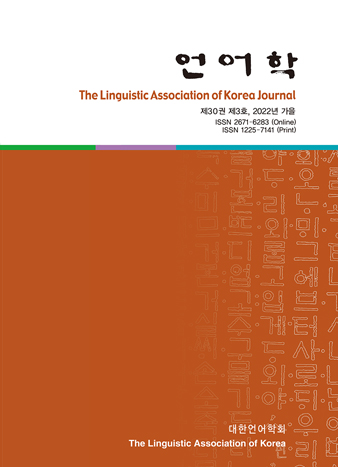대한언어학회 전자저널

30권 3호 (2022년 9월)
- 이해 및 산출실험과 코퍼스 분석에 나타난 한국어 재귀사의 결속 양상
-
김만경 · 이미선
Pages : 1-20
Abstract
Kim, Mankyung & Lee, Miseon. (2022). Binding of Korean reflexives in a comprehension task, a production task, and corpus analysis. The Linguistic Association of Korea Journal, 30(3), 1-20. It is well known that the binding domain of Korean reflexives is ambiguous. A few psycholinguistic studies have shown that caki and casin tend to prefer a long-distance antecedent while caki-casin strongly prefers a local antecedent. However, it should be noted that this pattern of binding preference has been obtained only using comprehension tasks. To assess the generalizability of the preference pattern, the present study examined the antecedent preference of Korean reflexives in a comprehension task, a production task, and a corpus analysis. The comprehension task showed similar binding patterns for caki, casin, and caki-casin to those of previous studies. Conversely, the production task and the corpus analysis revealed considerably different antecedent preferences for caki and casin. The task-related differences can be explained by the different pragmatic and morphosyntactic factors involved in comprehension and production. Modality (speaking vs. writing) can also make differences in the binding preference patterns.
Keywords
# 한국어 재귀사(Korean reflexives) # 결속영역 중의성(ambiguity of binding domain) # 이해실험(comprehension experiment) # 산출실험 (production experiment) # 코퍼스 분석(corpus analysis)
References
- 강범모. (1998). 문법과 언어 사용-코퍼스에 기반한 재귀사 ‘자기, 자신, 자기 자신’의 기 능 분석을 중심으로. 국어학, 31, 165-204.
- 김수정, 홍우평, 박기효, 이선경, 옥설아, 강가영, 남윤주. (2022). 한국어 대용어 결속원 리의 심리적 실재성. 통일인문학, 90, 255-290.
- 김용석. (1994). 재귀사의 장거리 결속 현상에 관한 자질 검사 이론적 접근. 언어연구, 12, 29-51.
- 김원호. (2013). 한국어의 재귀대명사: 형태와 기능. 언어과학, 20(1), 25-44.
- 목정수, 조서희. (2019). 이중 주어 구문 새로 보기-기본문형 설정과 관련하여. 국어국문 학, 196, 5-48.
- 박강희. (2002). 영.중.일.한. 재귀사 결속특징. 국제언어문학, 6, 221-238. 박강희. (2019). 단순, 복합재귀사 인칭별 비결속 제약. 언어연구, 35(2), 185-197. 양동휘. (1990). 대용화의 논리 형태. 성곡논총, 21, 719-760.
- 엄홍준. (2014). 한국어 재귀사 ‘자기‘의 속성. 언어, 39(4), 899-919.
- 엄홍준. (2015). 한국어 재귀사 ‘자기, 자신, 자기 자신’의 구조. 현대문법연구, 82, 53-65. 이선영, 서지혜, 정해권. (2017). 한국어 재귀사 ‘자기’의 처리 기제: 행동 반응 시간을 바탕으로. 언어와 언어학, 74, 229-248.
- 최광일, 김영진. (2003). 재귀대명사의 다의성 해소과정. 한국심리학회지: 인지 및 생물, 15(2), 239-257.
- 최광일, 김영진. (2007). 재귀대명사의 다의성 해소과정: 안구운동 분석. 한국심리학회지: 인지 및 생물, 19(4), 263-277.
- 함병호. (2018). 이중 주어 주문의 정보구조. 한국어학, 81, 325-360.
- Brennan, S. (1995). Centering attention in discourse. Language and Cognitive Processes, 10(2), 137-167.
- Cho, S.-W. (2006). The syntactic and semantic ambiguity of caki ‘self’ in Korean. Korean Linguistics, 12(1), 149-165.
- Chomsky, N. (1980). On binding. Linguistic Inquiry, 11, 1-46.
- Chomsky, N. (1981). Lectures on government and binding. Dordrecht: Foris.
- Chomsky, N. (1986). Knowledge of language: its nature, origin and use. New York: Praeger.
- Clark, E. V., & Hecht, B. F. (1983). Comprehension, production, and language acquisition. Annual Review of Psychology, 34, 325-349.
- Flynn, S. (1986). Production vs. comprehension: differences in underlying competences. Studies in Second Language Acquisition, 8(2), 135-164.
- Joo, K.-J. (2017). Children’s interpretation of the Korean reflexive pronouns caki and caki-casin. Language Acquisition, 24(4), 417-419.
- Kim, J.-H., & Yoon, J. (2008). An experimental syntactic study of binding of multiple anaphors in Korean. Journal of Cognitive Science, 9, 1-30.
- Kim, J.-H., Montrul, S., & Yoon, J. (2009). Binding interpretations of anaphors by Korean heritage speakers. Language Acquisition, 16(1), 3-35.
- Lee, K.-Y. (2008). The role of pragmatics in reflexive interpretation by Korean learners of English. In Proceedings of the 2007 Second Language Research Forum. Somerville, MA: Cascadilla Proceedings Project.
- Lee, S.-Y. (2012). The acquisition of Korean reflexive caki by heritage speakers and L2 learners. Korean Journal of Linguistics, 37(2), 383-400.
- Levorato, M. C., & Cacciari, C. (1995). The effects of different tasks on the comprehension and production of idioms in children. Journal of Experimental Child Psychology, 60(2), 261-83 .
- O’Grady, W. (2013). Processing and language acquisition: reflexive pronouns in English and Korean. Language and Information Society, 19, 33-59.
- Patterson, C. (2012). The effect of local discourse coherence on pronoun resolution: an eye-tracking study. Essex Graduate Student Papers in Language and Linguistics, 13, 96-119.
- Reinhart, T., & Reulant, E. (1993). Reflexivity. Linguistic Inquiry, 24(4), 657-720. Rohrbaher, B. (1999). Morphology-driven syntax: A theory of V to I raising and pro-drop. Amsterdam: John Benjamins Publishing Company.
- Stoet, G. (2010). PsyToolkit: A software package for programming psychological experiments using Linux. Behavior Research Methods, 42, 1096-1104.
- Yun, W.-H., Yoon, K.-C., Park, S.-W., Lee, J.-H., Cho, S.-M., Kang, D.-S., Byun, K.-H., Hahn, H.-S., & Kim, J.-S. (2015). The Korean corpus of spontaneous speech. Phonetics and Speech Sciences, 7(2), 103-109.